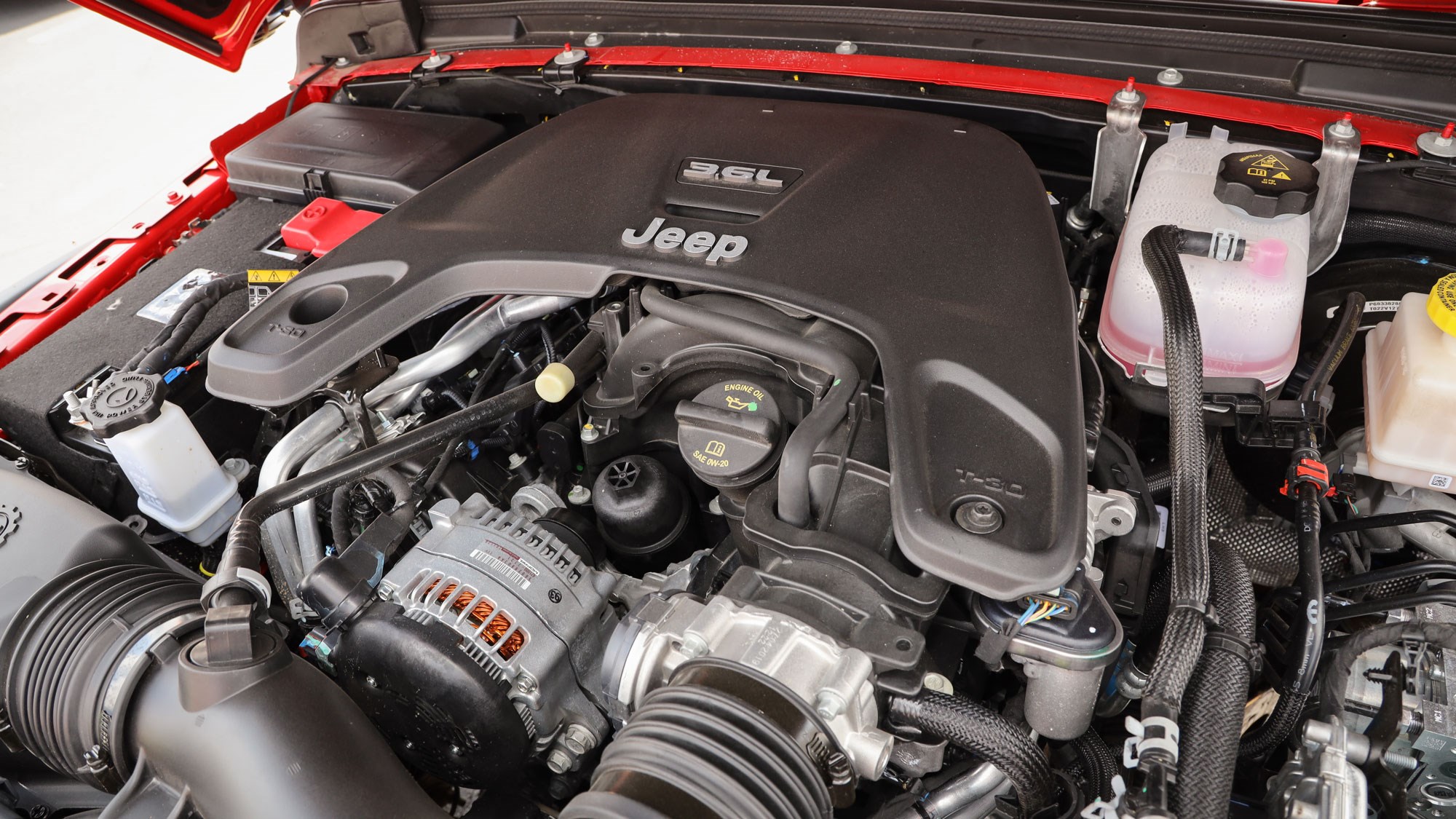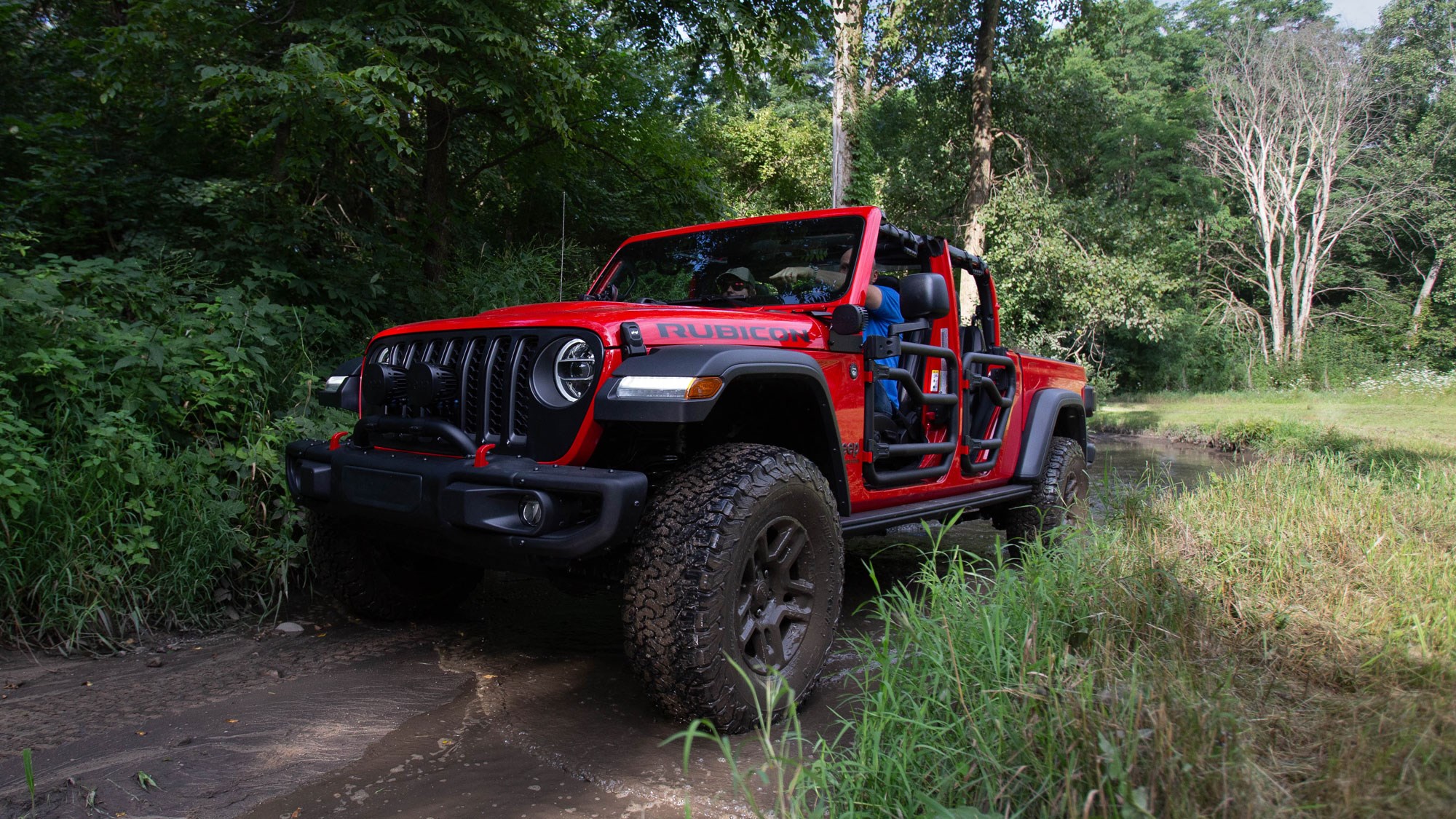► Super-sized pick-up truck version of Wrangler driven
► Tested on- and off-road in Mopar-modified Rubicon spec
► Reaches places no other pick-up will reach
Heading off-road with added truck – the Jeep Gladiator maintains almost all of the exceptional four-wheel drive capability of the Wrangler it’s based on, but has the added practicality of a lengthened chassis and a pick-up load bed bolted on at the back.
We’ve been driving it at Jeep’s Chelsea Proving Grounds, and on-road around America’s motor city heartland of Detroit.
Blimey. How big is this thing?
It is not small, that’s for sure. Total length is 5539mm, it’s 1875mm wide and the wheelbase is 3487mm; height varies with specification, as we’ll get to in a minute, but it’s 1882mm tall at a minimum.
For reference, that’s slightly longer and wider than a current Toyota Hilux.

It feels perfectly at home on US highways, but over here in the UK you’d be breathing in. A lot.
What’s going on with the doors?
Like every member of the Wrangler family, the Gladiator comes from the factory with doors designed for you to easily remove at home – not to mention a detachable roof panel, built in roll-cage, and a windscreen you can unbolt and fold down over the bonnet.
If it’s mud in the face (and pretty much everywhere else) you’re after, nothing comes close this side of an Ariel Nomad.
This particular Gladiator has been ‘Mopar-ised’ – which is to say it’s had a whole host of official Jeep Performance Parts thrown at it, and some of them have stuck. Hence the two-inch tube doors, mesh roof covering, and those super chunky tyres.

The roof covering is surprisingly good at keeping the sun at bay, if not the insects.
Surely those tyres don’t fit under the standard arches?
The bodywork is standard, the suspension is not – but coming in the form of a Mopar two-inch lift kit, it’s nothing a regular US customer can’t order (or even add to their finance package at the point of purchase – God bless America).
The kit includes new springs and control arms, as well as a set of heavy-duty Fox Racing dampers, creating enough room for tyres up to 37-inches in diameter. The wheels they’re fitted to are regular Mopar alloys, but 18-inch beadlock rims are also available for more extreme duty.
Polishing off the upgrades are a set of exceedingly bright LED off-road driving lights (each of the smaller ones is five times as bright as the headlights; the bigger ones are eight times as bright), a bunch of extra grab handles, and a Mopar cold air intake and cat-back exhaust that help the 282hp 3.6-litre petrol V6 breathe a little better.
The CAI comes with a vent for the bonnet, which can be paired with an optional snorkel if the standard 762mm wading depth isn’t enough for you.
Good off-road, is it?
The Gladiator comes in four trim levels: Sport, Sport S, Overland and Rubicon. All of them will crush your average SUV in terms of off-road performance – though things like Land Cruisers and the finally forthcoming new Defender may provide a bit of competition – but the Rubicon we’re driving here is where it gets really serious.
This gets a Rock-Trak 4×4 system with super-low range setting and mechanically locking differentials, rather than the Command-Trak with less aggressive crawl ratio and electronic diff locking only fitted to the rest of the line-up. The Rubicon also features a ‘smart sway-bar’ – which is to say an anti-roll bar that can be decoupled at the press of a button to further increase the suspension articulation.
In addition, Rubicon models feature steel bumpers for added toughness and larger 33-inch tyres as standard. This gives them an approach angle of 43.9 degrees, a breakover angle of 20.3 degrees and a departure angle of 26.0 degrees. Spot the green-lane enthusiasts by the raised eyebrow at this point.

The only one of these stat that’s significantly lower than a regular Wrangler Rubicon is the departure angle (37.0 degrees for the smaller Jeep), and the Gladiator has higher standard ground clearance (283mm). All of the figures are measured pre-Mopar lift kit and tyres, too, meaning the one we’re driving is still less troubled by pesky countryside obstructions.
Slide the optional eight-speed automatic gearbox into manual, and this activates a special accelerator map for first gear to smooth out response and boost low-speed control without the need for any kind of terrain management driving mode system.
In fact, smart bar and electronic diff-locks aside, the Gladiator eschews anything that doesn’t involve physical effort on the part of the driver – rather than use a switch, the four-wheel drive setting has to be selected via a lever that you can only move while rolling in neutral. It seems Jeep puts a premium on planning ahead, a habit ingrained by nearly 80 years of hardcore off-road experience.
Once you’ve got your head around this, and managed to jam the lever into low range, the Gladiator feels nigh-on unstoppable. The axle articulation is extraordinary before the ARB is disconnected, while the gearing gives such an outstanding crawl ratio you’re well into the engine’s 260lb ft at walking pace – meaning it’ll tackle some obstacles without the need for any pressure on the right pedal at all.

The only thing we have to worry about is not getting too carried away fording the swamp. And that’s only because this Gladiator doesn’t have any proper doors. The interior won’t be too bothered – everything inside is water sealed to the point that you can apparently use a pressure washer on the infotainment system, and the Mopar floor mats have drain plugs – but this water stinks so is best kept away from clothing and shoes.
Presumably all this makes it a proper truck on tarmac?
The big tyres and the extra suspension travel make it noisy and a little vague, but the ride is ok and as long as you remember to recouple the anti-roll bar (just another press of the button) it’s less disgruntled by corners than you might expect it to be.
Driving with no doors is a fun novelty, too. Probably half the Wranglers we encounter pottering around Detroit have theirs removed altogether, but the tube frames seem a sensible compromise. This is the first time Mopar has offered them, and they’re more substantial than the aftermarket alternatives while making use of factory hinges and latches for added safety.
The engine and eight-speed auto combo is a smooth and keenly engaging one – a six-speed manual is standard, but we can’t comment on that – while the Mopar exhaust is quiet enough to be entirely unobtrusive at cruising speeds. If the barking shout it makes under acceleration is too attention grabbing for you, perhaps you should think again about choosing a giant Tonka toy as your mode of transport.
Is it as sophisticated as a typical modern SUV? No. This is most definitely a 4×4 and not a Sports Utility Vehicle; it still features body-on-frame construction, and is built to be tough more than plush. But it’s not completely uncivilised, and size aside isn’t at all trying to drive.
Any differences inside compared with the Wrangler?
Up front the dashboard is the same. This is no bad thing, as the materials feel well up to the task and the layout – influenced by three early generations of Jeep, with a greater emphasis on horizontal lines than the immediate predecessor – is functional and attractive.
Rubicon models get a big flash of colour across the dash – a first for Jeep – as well as some red highlighting around the off-road controls, just to keep you focused on the primary purpose of the vehicle. It feels very much in keeping with this, too.
The back seat is bespoke to the Gladiator, and makes the most of the lengthened wheelbase to provide plenty of passenger space. The seats are substantial, supportive and didn’t cause us any comfort issues.
Fine. I now want to go wild camping – how much stuff can I carry?
The load bed, which as with all pick-ups is kept separate from the cabin so you can sling in camping gear and the occasional carcass without worrying about messing up the carpet, is sized 1531mm long by 1442mm wide. It can carry 725kg and tow up to 3.5-tonnes.
Towing aside, this doesn’t stand up too well against, say, a VW Amarok (especially the payload part), but you ultimately wouldn’t be able to go as far off-road in one of those.
The closest rival in the practicality / scenery smashing stakes is probably the Ford Ranger Raptor, but where that is built for cross-country speed, the Gladiator is built for rock-clinging endurance – although amusingly, the Gladiator’s circa 7.5sec 0-62mph time is around 3.0sec faster than the supposedly high-performance Ford can manage. The Raptor has a lower payload, too.

Sold – when does it go on sale in the UK, and is it as madly priced as the Raptor?
Here’s the bad news: the Gladiator is ‘not yet confirmed for the UK’. Which is usually press office code for ‘not coming ever at all’.
But! It is being produced in right-hand drive for other markets, so there is still hope it might turn up officially at some point. Ford seems confident it’s going to sell a stack of Raptors, so surely a few mighty G Rubicons could find homes here.
As for the price, in the USA the Gladiator starts at $33,545 (in the region of £27,500 at current exchange rates) – with the Rubicon version tested here starting at $43,545 before options (around £35,750). Make the comparison with UK Wrangler pricing versus the US, however, and we’re probably looking at a £50k pick-up here. Ouch.
Given the lack of confirmed arrival, worrying about whether this is good value is almost a moot point. But for what it’s worth (if you’ll excuse the pun), the Gladiator Rubicon packs bags of character alongside it’s outstanding capability, and it’ll be a real shame if it never makes an appearance in British showrooms.